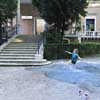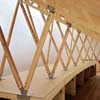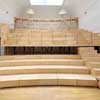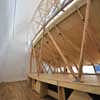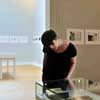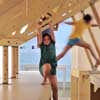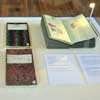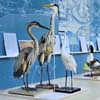Venice Architecture Biennale British Pavilion 2010, Villa Frankenstein, Exhibit, Images, Design
Venice Biennale British Pavilion : Architecture
International Architectural Exhibition, Italy – La Biennale di Venezia, Italia
26 Aug 2010
Venice Biennale British Pavilion
BRITISH PAVILION OPENS AT THE 12th INTERNATIONAL ARCHITECTURE EXHIBITION, VENICE
The British Pavilion at the 12th International Architecture Exhibition in Venice, commissioned by Vicky Richardson, Director of Architecture, Design, Fashion at the British Council – the UK’s leading educational and cultural relations organisation – and under the direction of muf architecture/art Llp, opens to the public on Sunday 29 August 2010.
The Pavilion is ironically reframed Villa Frankenstein, making direct reference to the ideas of the British Victorian social critic and historian of Venetian architecture John Ruskin. It has been conceived by muf as a stage for an exchange of ideas between Venice and the UK. The centrepiece of the Pavilion, represented as a ‘Stadium of Close Looking’, will be a 1/10 scale model of a section of the Olympic Stadium for London 2012, reinterpreted by muf with atelier one engineers, and built by Venetian carpenters Spazio Legno. This hybrid structure will act as a platform for drawing, discussion and scientific enquiry. Following its use at the Pavilion, it will be reconstructed on another site in Venice as a lasting legacy of the project.
Venice Biennale British Pavilion in 2010:
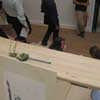
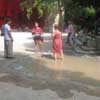
photos © Adrian Welch
The ‘Made in Venice’ theme is continued through a series of separate installations in the Pavilion including a 15 square metre ecologically functioning slice of salt marsh showing a close-up view of the native floral and fauna of the Venice Lagoon. Other exhibits include a new project by Wolfgang Scheppe drawing on both Ruskin’s original notebooks and a series of historical photographs of Venice taken by local residents, Alvio and Gabriella Gavagnin. Seven of Ruskin’s Venetian Notebooks (1849-50) are being lent by the Ruskin Foundation from the Ruskin Library at Lancaster University, and there will be inter-active electronic access to his research in Venice.
Debates, workshops, drawing classes and scientific discussions will take place during the three months of the Biennale, which will lead to a catalogue, edited by Adrian Dannatt, to be published in three chapters across the period of the Biennale, acting as a further creative platform to inform thinking for London as it moves towards 2012.
Vicky Richardson, Director of Architecture, Design, Fashion at the British Council, said: “Villa Frankenstein shifts our perception of Venice as a historic backdrop to the Biennale, to one of a dynamic participant. muf has introduced many new collaborators to the British Pavilion including the schools of Venice, the scientific community, community activists, historians and artists. By emphasising the importance of close looking and observation, which takes many different forms, muf demonstrates an alternative approach to architecture based on understanding what we already have.”
Liza Fior, co-Founder of muf architecture/art Llp, said: “Even before John Ruskin and The Stones of Venice, the British have been preoccupied with Venice and in different ways have taken the city home. Villa Frankenstein attempts to breach the Giardini fence by bringing Venice and some of its preoccupations inside the Pavilion as a series of diverse collaborations.”
muf was established in London in 1995. The practice has an international reputation for its site-specific research driven public projects, which negotiate between the built and social fabric; between public and private spaces. Current projects are predominantly focused in East London around the approaches and margins of the Olympic site, but not exclusively so. Projects range from urban design schemes to temporary interventions, landscapes and buildings. Awards for muf projects include the 2008 European Prize for Public Space (the first UK winner) for a new Barking town square, East London. Publications include This is What We Do: a muf manual. The partners are visiting professors at Yale, where their last studio explored alternative legacies for London’s Olympic site.
Venice Architecture Biennale British Pavilion – invited collaborators
– Lorenzo Bonometto, President of the Società Veneziana di Scienze Naturali
– Lottie Child, artist
– Jane da Mosto, environmental scientist, advisor to Venice in Peril
– Professor Robert Hewison, cultural historian, author of Ruskin on Venice: “The Paradise of Cities”
– ReBiennale, Venice based international collective
– Wolfgang Scheppe, artist-philosopher
– Dr Tom Spencer, Director of the Cambridge Coastal Research Unit and Senior Lecturer in Geography, Cambridge University
– Professor Stephen Wildman, Director of The Ruskin Library and Research Centre, Lancaster University
Venice Biennale British Pavilion : main page with current information
Venice Biennale British Pavilion 2012
Venice Biennale – Exhibitions, Designs, Images

photo : Neale Smith Photography
The British Pavilion at the 12th Venice Architecture Biennale
Giardini della Biennale, Venice
29 Aug – 21 Nov 2010
The British Council’s commitment to the Architecture Biennale is illustrative of how the UK’s creative industries contribute powerfully to the development of cultural relations worldwide. The British Council is responsible for the British Pavilion in Venice, showing British artists at the longest-running, most prestigious international art Biennial in the world: the Venice Biennale of Art. From 1991 the British Pavilion has also been home to architecture exhibitions in the alternate years to the art Biennale.
The British Council works with an advisory panel of leading architecture professionals across the UK which assists with the selection for the Venice Biennale every two years.
Venice Biennale Advisory Panel, 2010 Members
– Christopher Egret, Director, Studio Egret West
– Kathryn Findlay, Director, Ushida Findlay Architects
– Pedro Gadanho, Professor at Faculty of Architecture, the University of Porto
– Michael Hegarty, Director, PLACE
– Sarah Ichioka, Director, The Architecture Foundation (and Chair of the panel)
– Kieran Long, Architecture critic, Evening Standard
– Andrea Rose, Director of Visual Arts, British Council
Location: Venice, Italy
Venice Architecture
Venice Architecture Designs – chronological list
Venice Architecture Tours by e-architect
Venice Architecture Biennale Danish Pavilion
Venice Architecture Biennale 2010, Exhibit
Website: La Biennale di Venezia
Venice Biennale exhibition 2007 : Dune Formations installation, Scuola dei Mercanti
Comments / photos for the Villa Frankenstein – Venice Biennale British Pavilion page welcome
Venice Biennale British Pavilion 2010
Website : www.venicebiennale.britishcouncil.org

